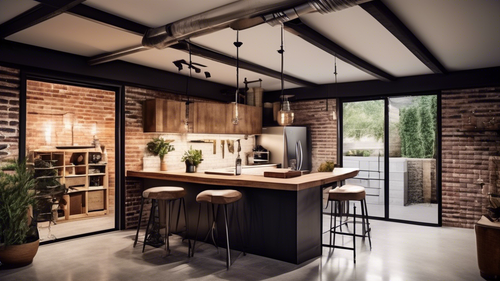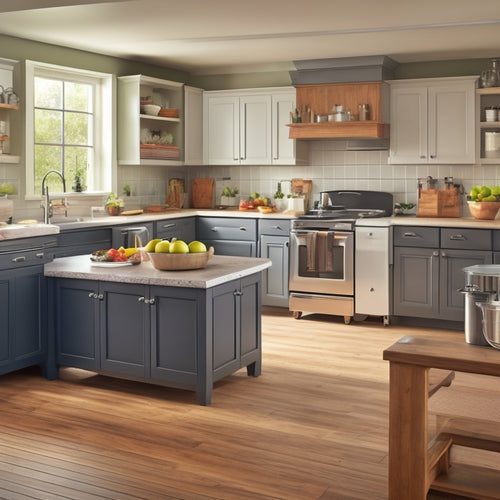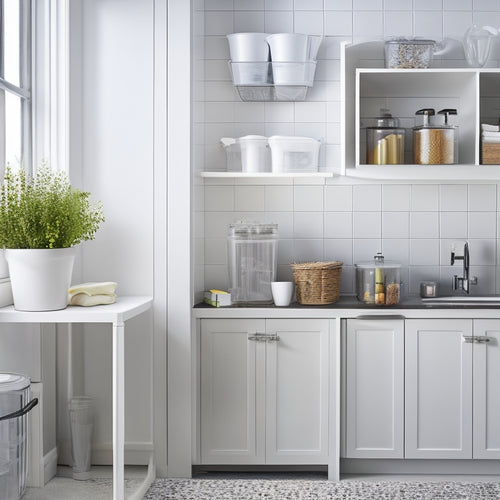
Strategic Solutions: Mastering Large Family Closet Chaos
Share
Mastering large family closet chaos requires a strategic approach that considers the unique needs of each family member, optimizes storage solutions for growth, and promotes unity through thoughtful design. A well-organized closet begins with identifying hidden storage areas and maximizing limited space. Each family member should have designated areas tailored to their individual needs, with stackable bins and shelves for easy access. By implementing storage solutions that adjust to growth, families can guarantee a seamless shift between sizes and styles. To achieve a harmonious and functional closet space, explore the art of balancing individuality with unity.
Key Takeaways
• Identify hidden storage areas and convert unused corners and shelves to maximize limited space and minimize clutter.
• Designate separate areas for each family member, incorporating stackable bins and shelves for easy access to personal items.
• Implement a growth-oriented storage system, progressing clothes to labeled bins by size and designating a section for future needs.
• Create customized compartments and a cohesive aesthetic to promote unity and cooperation among family members.
• Reassess storage solutions regularly to ensure the closet remains functional, harmonious, and adapted to the family's changing needs.
Taming the Closet Chaos
By acknowledging the unique challenges of large family closet organization, parents can begin to tame the closet chaos by reassessing their storage solutions and exploring creative ways to optimize their available closet space.
Closet optimization is vital in maximizing the use of limited space, making the most of every nook and cranny. One effective strategy is to identify hidden gems within the closet, such as unused corners or shelves, and convert them into functional storage areas.
Organizing for Every Family Member
Large family closet organization requires a tailored approach for each family member, taking into account their unique needs, preferences, and ages to create a harmonious and functional closet space. This means designing a kids' closet that adapts to their growth and changing needs, while also accommodating the parental wardrobe. Effective organization strategies for each family member can make a significant difference in maintaining a clutter-free closet.
| Family Member | Organization Strategy |
|---|---|
| Kids | Designate separate areas for different ages, use stackable bins and shelves for easy access |
| Parents | Implement a minimalist approach, utilize double rods for maximum storage |
| Younger Girls | Incorporate dress-up stations and creative storage solutions for accessories |
| Older Girls | Provide individual dressers and shelves for personal items |
| Boys | Utilize soft-sided bins and shelves for organized storage of clothing and treasures |
Storage Solutions for Growth
As children grow and outgrow their clothes, implementing effective storage solutions becomes essential to maintaining a clutter-free closet and ensuring a smooth shift to the next size.
To accommodate growth, consider progressing clothes to storage bins or containers labeled by size, making it easy to retrieve items as needed. This approach allows for a seamless handoff to the next size, reducing clutter and stress.
Additionally, designate a section of the closet for future needs, storing clothes that are yet to be outgrown. By implementing these strategies, you'll create a well-organized closet that adapts to your child's growth, providing a sense of control and calm in the midst of chaos.
Designing for Family Harmony
Designing a closet that accommodates the diverse needs of family members is a key component of achieving harmony, and it begins with understanding the unique requirements of each individual. By acknowledging and respecting individual styles within shared spaces, families can create a sense of unity while still catering to personal preferences.
Customized compartments and unified design elements can help achieve this balance. For instance, designated areas for each family member's belongings can be created, while a cohesive aesthetic ties the space together. By striking this balance, families can create a harmonious and functional closet space that meets the needs of all, promoting a sense of unity and cooperation.
Frequently Asked Questions
How Do You Maintain Organized Closets With Frequent Laundry Cycles?
To maintain organized closets amidst frequent laundry cycles, implement a consistent laundry schedule and adopt cycle hacks, such as sorting and prioritizing loads, utilizing laundry baskets with separate compartments, and designating a 'launching pad' for clean clothes to guarantee efficient put-away.
Are There Closet Systems Designed Specifically for Large Families?
"Measure twice, cut once" - a principle that applies to designing efficient closet systems. Large families can benefit from custom designs featuring shared compartments, maximizing storage and streamlining organization, making the most of available space.
Can a Family Closet Concept Work in a Small or Older Home?
In small or older homes, a family closet concept can be adapted with space-savvy design solutions, overcoming design dilemmas by incorporating vertical storage, multi-functional fixtures, and clever layout planning to maximize available space.
How Do You Balance Individuality With Shared Closet Space for Kids?
To balance individuality with shared closet space for kids, utilize personalized bins and designated zones within the closet, allowing each child to maintain their own space while fostering a sense of shared responsibility and organization.
Are There Any Closet Organization Apps or Tools for Large Families?
Leverage cutting-edge technology by utilizing virtual assistants and digital planners specifically designed for large families, such as Sortly or ClosetMaid, to streamline closet organization, assigning tasks, and tracking inventory with ease and precision.
Conclusion
To sum up, the key to mastering large family closet chaos lies in adopting a multifaceted approach that incorporates tailored organizational strategies, innovative storage solutions, and harmonious design elements.
By doing so, the closet is transformed from a cluttered abyss to a serene oasis, where every family member can effortlessly find what they need.
Much like a skilled navigator charting a course through treacherous waters, arriving at a haven of tranquility and functionality.
Related Posts
-

Transforming Your Garage into a Haven of Style
Is your garage an unorganized chaos of clutter and forgotten dreams? Don't despair! With a little imagination and...
-

DIY Island With Built-In Trash and Recycling Station
You're about to create a kitchen island that's both functional and stylish, with a built-in trash and recycling stati...
-

Corner Solutions for Kitchen Cleaning Supplies
You can investigate corner solutions that improve access to cleaning supplies. This can be practiced by maximizing hi...


